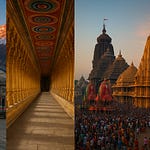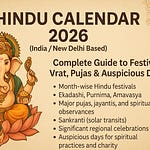📍 Location: Suchindram, Kanyakumari District, Tamil Nadu
🧭 Type of Temple: Trimurti Temple (Shaiva-Vaishnava-Smarata blend)
The Suchindram Shri Thanumalayan Swamy Temple is a spiritual treasure trove nestled in the serene town of Suchindram, just a few kilometers from Kanyakumari, the southernmost tip of India. This sacred temple is one of the few temples in India where the Trimurti—Brahma (Ayan), Vishnu (Mal), and Shiva (Sthanu)—are worshipped in a single sanctum sanctorum in the form of Thanumalayan.
Suchindram is not just a geographical landmark but a spiritual junction, representing the unity of diverse traditions—Shaivism, Vaishnavism, and Smarata Sampradaya. The temple's historical importance, architectural excellence, and religious power make it a must-visit for every devotee and pilgrim.
🏛️ Foundation & Origin
📖 Mythological Roots
The name Suchindram is derived from the Sanskrit word "Suchi" meaning purity. Legend has it that Lord Indra, the king of Devas, visited this place to absolve his sins and regain purity. After penance here, he was purified, and the place was named "Suchindram."
According to temple lore, the trinity (Trimurti) once appeared here to bless Anasuya Devi, wife of the sage Atri. To test her chastity, the gods asked her to serve them food unclothed. Using her yogic powers, she transformed them into infants and fed them. Pleased by her devotion, they granted her a boon and merged into a single deity—Thanumalayan.
🏗️ Construction & History
The temple is believed to be more than 1,500 years old, with contributions from Cheras, Cholas, Pandyas, and the Nayaks of Travancore. It was significantly renovated in the 17th century, and its architecture today reflects a synthesis of Dravidian and Kerala-style temple architecture.
🕉️ Religious Significance
Thanumalayan represents Brahma (Thanu), Vishnu (Mal), and Shiva (Ayan)—a rare Trimurti worship in a single form.
The temple is a sacred pilgrimage site for Shaivites, Vaishnavites, and Smarthas alike.
Indra’s purification at this site is still commemorated through rituals, attracting spiritual seekers year-round.
The place is also associated with celibacy and purity, hence many bachelors and devotees of Hanuman visit here for strength and blessings.
🏯 Temple Architecture & Highlights
Gopuram: The 134-foot-high white gopuram (tower) is visible from a distance and richly adorned with sculptures.
Four Musical Pillars: Carved out of a single stone, these pillars produce different musical notes.
Hanuman Idol: A massive 22-foot-tall monolithic statue of Lord Hanuman, one of the tallest in India.
Nandi: A giant 13-foot high and 21-foot long Nandi (bull) made of mortar and lime, among the largest in South India.
Shrines: Shrines for Vishnu, Shiva, Brahma, Devi, Subrahmanya, Hanuman, Indra, and more.
🙏 Pujas, Aarti, and Rituals
Daily Schedule (subject to slight changes during festivals):
The temple opens early in the morning at 4:30 AM.
From 5:00 AM to 6:00 AM, the Abhishekam and Alankaram (holy bathing and decoration of the deity) are performed.
The Morning Aarti takes place at 6:30 AM, offering divine energy and blessings to the devotees.
The Ucchi Kaala Pooja (midday offering) is conducted at 11:00 AM.
The temple closes for the afternoon at 12:30 PM.
It reopens for evening darshan at 4:00 PM.
The Deeparadhana (evening lamp offering) is performed at 6:00 PM.
The Night Puja takes place at 8:00 PM, marking the final set of rituals for the day.
The temple closes for the night at 8:30 PM.
Rituals to Witness:
Abhishekam to the Trimurti Lingam
Hanuman Jayanti Vishesha Puja
Navagraha Shanti Homa
Milk and Sandalwood Abhishekams
Rudra Abhishekam on Mondays
📅 Festivals Celebrated
🌺 Margazhi Bhrammotsavam (Dec–Jan)
A 10-day grand festival with daily rathotsavams (chariot processions).
Deities are taken out on different vahanas including Garuda, Nandi, and Hanuman.
🌸 Chithirai Festival (April–May)
Celebrates celestial marriage of the deity.
Involves music, folk art, and large-scale community feasts.
🌙 Maha Shivaratri
Night-long prayers, chanting, and darshan.
Devotees observe fasting and perform Rudra abhishekam.
📿 Vaikunta Ekadashi & Navaratri
Observed with special Vishnu-centric rituals, deepa alankaram, and satsang.
🔥 Kanikaanal Utsavam
Local to Suchindram, involves special offerings, devotional music, and community feasting.
📖 Satsangs, Tirtha, and Spiritual Practices
Satsangs and bhajan mandalis often gather near the temple tank.
Devotees chant Thanumalayan Ashtothram and Hanuman Chalisa.
Pilgrims take holy dips in the temple tank (Tirtha Kulam), believed to purify karmas.
Walking pradakshina around the temple in silence is considered highly meritorious.
🧭 Travel & Visit Guide
📌 How to Reach
By Air: Nearest airport is Trivandrum International Airport (70 km).
By Rail: Nagercoil Junction (6 km) and Kanyakumari Railway Station (12 km) are closest.
By Road: Well-connected by buses and taxis from Trivandrum, Nagercoil, Madurai, and Kanyakumari.
🏨 Nearby Stays
Budget lodges and hotels available in Suchindram and Nagercoil.
Pilgrims can also find dharamshalas and temple guesthouses.
🕰️ Best Time to Visit
November to February (Pleasant climate and festival season)
Avoid peak summer due to high humidity
⚠️ Important Tips for Devotees
Dress Modestly: Traditional Indian attire is recommended (Dhoti for men, Saree/Salwar for women).
Footwear: Leave shoes outside designated area.
Phones and Cameras: Strictly prohibited inside inner sanctum.
Crowds: Expect large gatherings during Margazhi and Chithirai festivals.
Language: Tamil is spoken widely, but temple priests can assist in Sanskrit and basic English.
The Suchindram Shri Thanumalayan Swamy Temple is more than a religious monument—it is a spiritual powerhouse that harmonizes the cosmic energies of the Creator (Brahma), Preserver (Vishnu), and Destroyer (Shiva) into one sacred embodiment. A visit here is not just a pilgrimage, but a journey into India’s spiritual unity, architectural glory, and timeless devotion.
Whether you are a seeker of moksha, a lover of temple art, or simply a devotee looking for divine blessings—Thanumalayan Temple welcomes you with sanctity, serenity, and spiritual nourishment.










